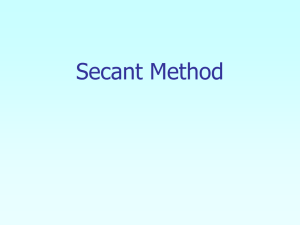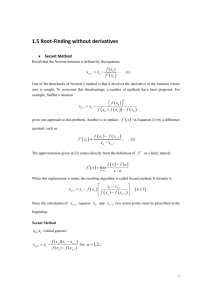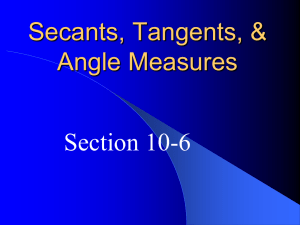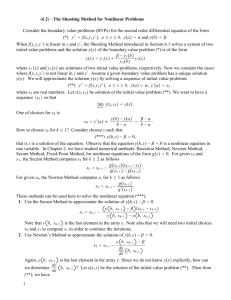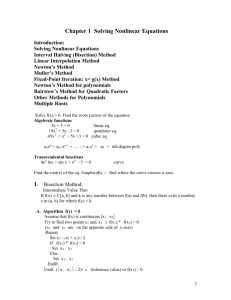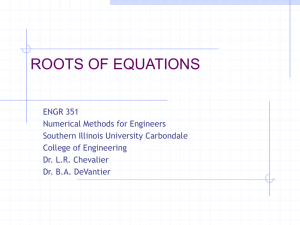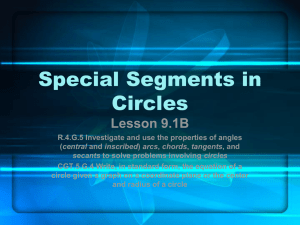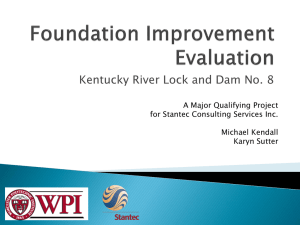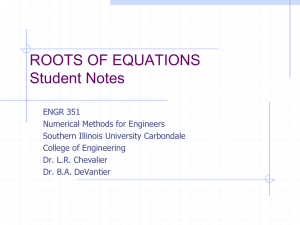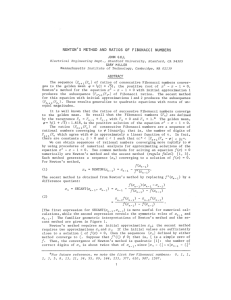Secant Method: Solving Nonlinear Equations
advertisement
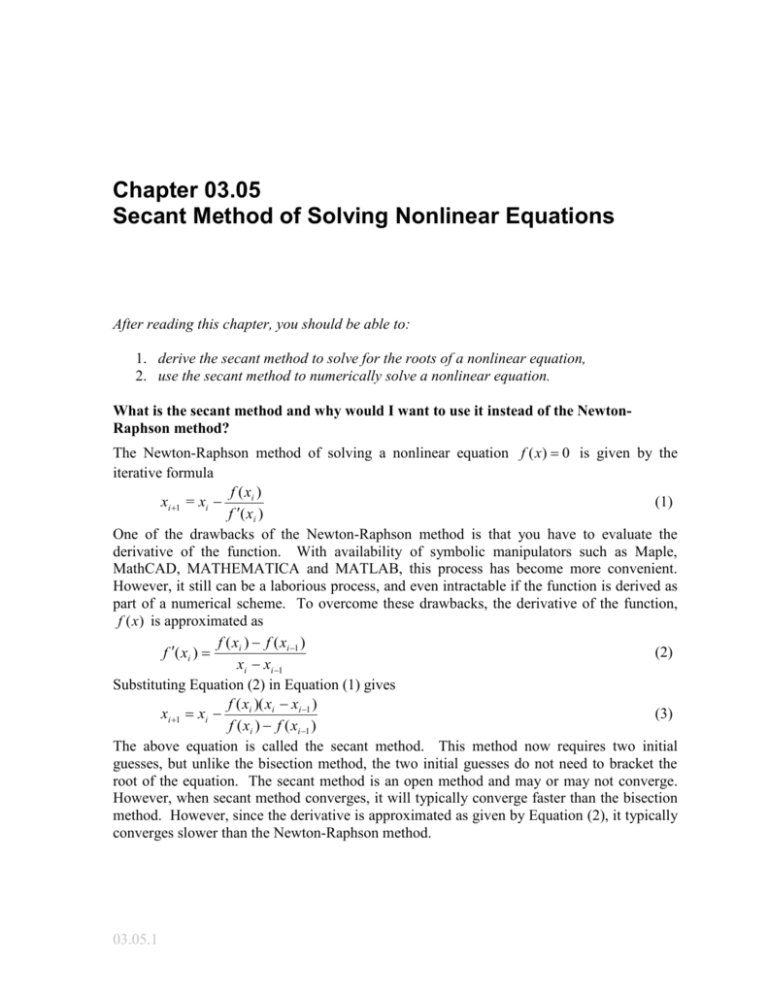
Chapter 03.05 Secant Method of Solving Nonlinear Equations After reading this chapter, you should be able to: 1. derive the secant method to solve for the roots of a nonlinear equation, 2. use the secant method to numerically solve a nonlinear equation. What is the secant method and why would I want to use it instead of the NewtonRaphson method? The Newton-Raphson method of solving a nonlinear equation f ( x) 0 is given by the iterative formula f ( xi ) (1) xi 1 = xi f ( xi ) One of the drawbacks of the Newton-Raphson method is that you have to evaluate the derivative of the function. With availability of symbolic manipulators such as Maple, MathCAD, MATHEMATICA and MATLAB, this process has become more convenient. However, it still can be a laborious process, and even intractable if the function is derived as part of a numerical scheme. To overcome these drawbacks, the derivative of the function, f (x ) is approximated as f ( xi ) f ( xi 1 ) (2) f ( xi ) xi xi 1 Substituting Equation (2) in Equation (1) gives f ( xi )( xi xi 1 ) (3) xi 1 xi f ( xi ) f ( xi 1 ) The above equation is called the secant method. This method now requires two initial guesses, but unlike the bisection method, the two initial guesses do not need to bracket the root of the equation. The secant method is an open method and may or may not converge. However, when secant method converges, it will typically converge faster than the bisection method. However, since the derivative is approximated as given by Equation (2), it typically converges slower than the Newton-Raphson method. 03.05.1 03.05.2 Chapter 03.05 The secant method can also be derived from geometry, as shown in Figure 1. Taking two initial guesses, xi 1 and xi , one draws a straight line between f ( xi ) and f ( xi 1 ) passing through the x -axis at xi 1 . ABE and DCE are similar triangles. Hence AB DC AE DE f ( xi ) f ( xi 1 ) xi xi 1 xi 1 xi 1 On rearranging, the secant method is given as f ( xi )( xi xi 1 ) xi 1 xi f ( xi ) f ( xi 1 ) f (x) f (xi) B f (xi–1) C E xi+1 A D xi–1 xi x Figure 1 Geometrical representation of the secant method. Example 1 You are working for ‘DOWN THE TOILET COMPANY’ that makes floats (Figure 2) for ABC commodes. The floating ball has a specific gravity of 0.6 and a radius of 5.5 cm. You are asked to find the depth to which the ball is submerged when floating in water. The equation that gives the depth x to which the ball is submerged under water is given by x 3 0.165 x 2 3.993 10 4 0 Use the secant method of finding roots of equations to find the depth x to which the ball is submerged under water. Conduct three iterations to estimate the root of the above equation. Find the absolute relative approximate error and the number of significant digits at least correct at the end of each iteration. Secant Method 03.05.3 Solution f x x 3 0.165 x 2 3.993 10 4 Let us assume the initial guesses of the root of f x 0 as x1 0.02 and x0 0.05 . Figure 2 Floating ball problem. Iteration 1 The estimate of the root is f x0 x0 x1 x1 x0 f x0 f x1 x0 x 3 0 x 3 0 0.05 0.165 x 3.993 10 2 0 0.05 0.06461 3 0.165 x02 3.993 10 4 x0 x1 0.05 3 4 x 3 1 2 0.165 x21 3.993 10 4 0.1650.05 3.993 10 4 0.05 0.02 0.1650.05 3.993 10 4 0.023 0.1650.02 3.993 10 4 2 2 The absolute relative approximate error a at the end of Iteration 1 is a x1 x0 100 x1 0.06461 0.05 100 0.06461 22.62% The number of significant digits at least correct is 0, as you need an absolute relative approximate error of 5% or less for one significant digit to be correct in your result. Iteration 2 x2 x1 x1 f x1 x1 x0 f x1 f x0 x 3 1 x 3 1 0.165 x12 3.993 10 4 x1 x0 0.165 x12 3.993 10 4 x03 0.165 x02 3.993 10 4 03.05.4 Chapter 03.05 0.06461 0.06461 0.1650.06461 2 3 0.06461 0.1650.06461 2 3 3.993 10 4 0.06461 0.05 3.993 10 4 0.053 0.1650.05 3.993 10 4 2 0.06241 The absolute relative approximate error a at the end of Iteration 2 is a x2 x1 100 x2 0.06241 0.06461 100 0.06241 3.525% The number of significant digits at least correct is 1, as you need an absolute relative approximate error of 5% or less. Iteration 3 f x2 x2 x1 f x2 f x1 x3 x2 x2 0.06241 x x 3 2 3 2 0.165 x22 3.993 10 4 x2 x1 0.165 x22 3.993 10 4 x13 0.165 x12 3.993 10 4 0.06241 0.1650.06241 2 3 0.06241 0.1650.06241 3 2 3.993 10 4 0.06241 0.06461 3.993 10 4 0.064613 0.1650.06461 3.993 10 4 2 0.06238 The absolute relative approximate error a at the end of Iteration 3 is a x3 x2 100 x3 0.06238 0.06241 100 0.06238 0.0595% The number of significant digits at least correct is 2, as you need an absolute relative approximate error of 0.5% or less. Table 1 shows the secant method calculations for the results from the above problem. Table 1 Secant method results as a function of iterations. Iteration xi 1 xi 1 xi a % Number, i 22.62 1 0.02 0.05 0.06461 3.525 2 0.05 0.06461 0.06241 0.0595 3 0.06461 0.06241 0.06238 4 0.06241 0.06238 0.06238 3.64 10 4 f xi 1 1.9812 10 5 3.2852 10 7 2.0252 10 9 1.8576 10 13 Secant Method 03.05.5 NONLINEAR EQUATIONS Topic Secant Method for Solving Nonlinear Equations. Summary These are textbook notes of secant method of finding roots of nonlinear equations. Derivations and examples are included. Major General Engineering Authors Autar Kaw Date February 6, 2016 Web Site http://numericalmethods.eng.usf.edu
